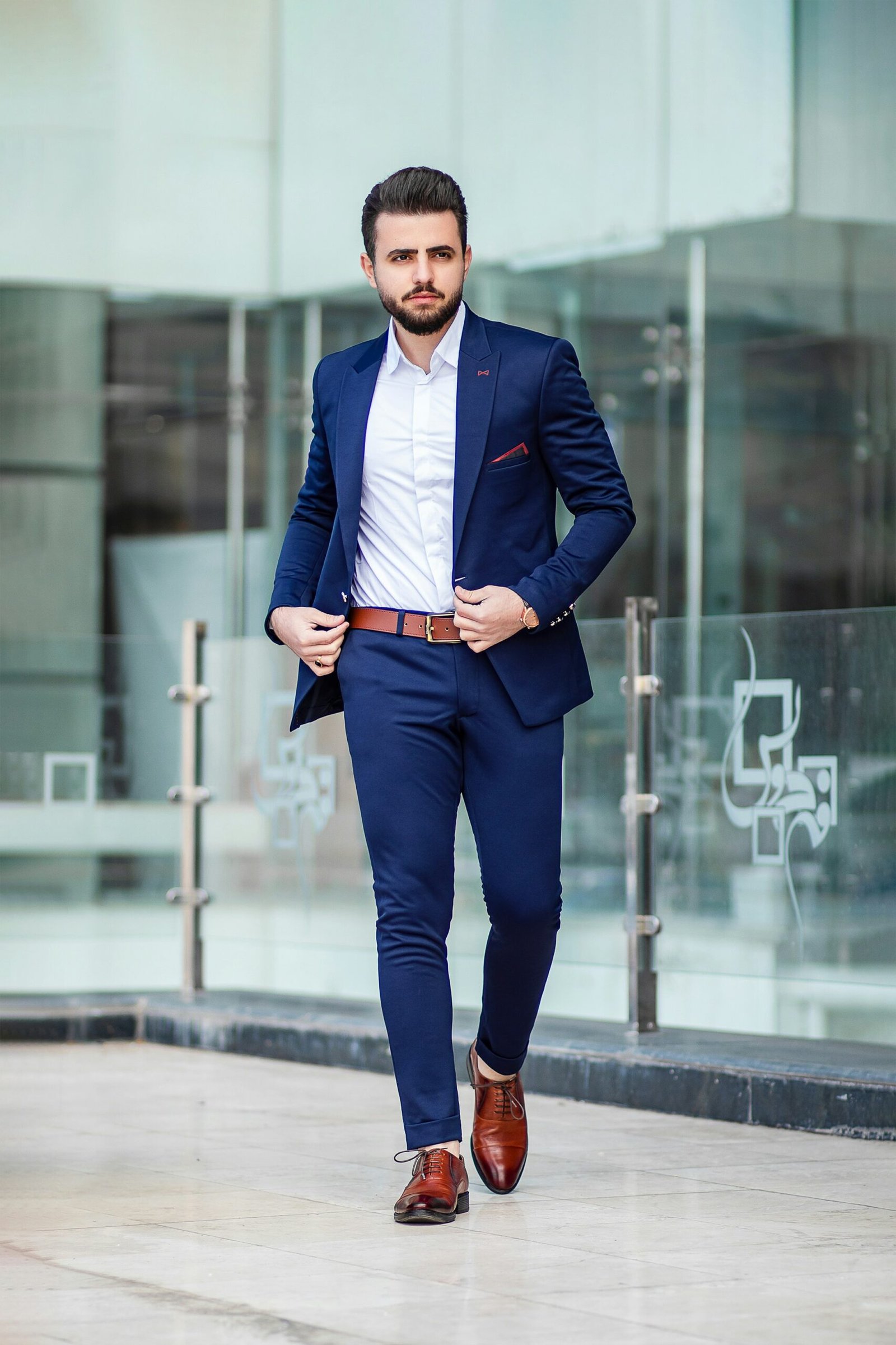
The journey of men’s fashion begins in the early 20th century, where classic styles dominated the scene. During this time, men’s fashion was characterized by tailored suits, crisp white shirts, and polished leather shoes. The emphasis was on clean lines, impeccable fit, and a refined aesthetic. Men were expected to dress formally and adhere to a strict dress code, which often included hats and gloves.
As the 20th century progressed, men’s fashion started to evolve, influenced by various cultural and social movements. The 1920s marked a significant shift in men’s fashion, with the rise of the “Roaring Twenties” and the Jazz Age. This era saw the emergence of the “flapper” style for women, characterized by short skirts, bobbed hair, and a more liberated attitude towards fashion. Men’s fashion also experienced a change, with looser-fitting suits, wider trousers, and the introduction of casual wear such as sports jackets and sweaters.
The 1930s and 1940s brought about a more conservative approach to men’s fashion, due to the Great Depression and World War II. Suits became more structured and tailored, reflecting the need for practicality and durability. The 1950s saw a return to elegance and sophistication, with the emergence of the “Mad Men” style. This era was characterized by slim-fitting suits, narrow ties, and polished shoes.
In the 1960s and 1970s, men’s fashion took a bold turn, influenced by the counterculture movements and the rise of rock ‘n’ roll. The “mod” style became popular, with its vibrant colors, bold patterns, and unconventional silhouettes. Bell-bottom trousers, psychedelic prints, and platform shoes were all the rage. The 1980s brought about a more polished and extravagant look, with power suits, shoulder pads, and flashy accessories.
In recent years, men’s fashion has become more diverse and inclusive, with a focus on individuality and self-expression. The rise of streetwear and athleisure has blurred the lines between casual and formal wear, with hoodies, sneakers, and joggers becoming acceptable in various settings. Fashion designers have also been pushing boundaries, experimenting with gender-neutral clothing and challenging traditional norms.
Today, men’s fashion is a reflection of personal style and individuality. It is no longer confined to rigid rules and dress codes but embraces creativity and self-expression. Whether it’s a tailored suit for a formal occasion or a casual ensemble for everyday wear, men now have the freedom to experiment with different styles and create their own unique looks.
During the classic era, men’s fashion was not only about the clothes they wore but also about the way they carried themselves. It was a time when manners and etiquette were highly valued, and a gentleman was expected to conduct himself with grace and poise. This emphasis on refinement extended beyond clothing and encompassed all aspects of a man’s life.
In addition to their impeccable style, gentlemen of the classic era were also known for their intellectual pursuits and cultural refinement. They were well-read and well-spoken, engaging in lively discussions on topics ranging from literature to politics. They frequented the opera, attended art exhibitions, and participated in intellectual salons, further enhancing their reputation as men of taste and sophistication.
The classic era was also a time of social stratification, with different classes of men adhering to specific fashion norms. The upper class, for example, favored tailored suits in dark colors, while the working class often wore simpler, more practical attire. However, regardless of social status, men in this era took pride in their appearance and made an effort to present themselves in the best possible light.
The classic era of men’s fashion was not without its challenges, though. The strict dress codes and societal expectations placed a considerable burden on men, demanding that they always be dressed appropriately for every occasion. This meant having a wardrobe that catered to various events, from formal dinners to casual outings. It required careful planning and attention to detail to ensure that one’s attire was always on point.
Despite these challenges, the classic era remains a source of inspiration for modern men’s fashion. The timeless elegance and attention to detail that defined this period continue to influence designers and stylists today. From the tailored suits to the polished shoes, the classic era serves as a reminder that true style is not fleeting but enduring.
In conclusion, the classic era of men’s fashion was a time of timeless elegance and sophistication. Men dressed in tailored suits and paid meticulous attention to detail, exuding a sense of refinement in their appearance. Beyond clothing, they were expected to conduct themselves with grace and engage in intellectual pursuits. Though the fashion norms of this era were strict, they continue to inspire modern men’s fashion, reminding us that true style stands the test of time.
As the casual revolution continued to shape men’s fashion, designers began to experiment with new fabrics and silhouettes. Synthetic materials such as polyester and nylon became popular choices for clothing, as they were lightweight and easy to care for. These fabrics allowed for greater freedom of movement and added to the overall comfort of casual attire.
The mid-century modern era also saw the introduction of new styles and trends in men’s accessories. The popularity of sunglasses soared, with aviator and wayfarer styles becoming iconic. Men also embraced the use of scarves, not only for warmth but also as a fashion statement. The scarf became a versatile accessory that could be worn with both casual and formal outfits.
Another significant development during this time was the emergence of the unisex fashion movement. As women began to adopt a more androgynous style, men also started to experiment with clothing traditionally associated with the opposite sex. The boundaries between men’s and women’s fashion became blurred, and this era witnessed the rise of gender-neutral clothing.
The casual revolution not only influenced the way men dressed but also had a profound impact on the fashion industry as a whole. Designers started to create collections that catered to the growing demand for casual clothing, and new brands emerged that focused solely on producing casual wear. The concept of “ready-to-wear” became more prevalent, as men sought clothing that was both stylish and convenient.
Overall, the mid-century modern era was a time of significant change in men’s fashion. The casual revolution brought about a shift in attitudes towards dressing, emphasizing comfort and individuality. This era laid the foundation for the casual styles that continue to dominate men’s fashion today.
Furthermore, the contemporary era of men’s fashion has witnessed a shift towards inclusivity and diversity. Designers and brands are now embracing models of different races, body types, and ages, challenging the long-standing notion of the “ideal” male body. This push for inclusivity not only promotes a more realistic representation of men but also allows individuals from all walks of life to feel represented and included in the fashion industry.
Moreover, technology has played a crucial role in shaping contemporary men’s fashion. With the rise of e-commerce and online shopping, men now have access to a vast array of clothing options from around the world. This has not only expanded their choices but has also made fashion more accessible to a wider audience. Additionally, advancements in fabric technology have led to the development of innovative materials that offer enhanced comfort, durability, and functionality.
Another notable aspect of contemporary men’s fashion is the increasing emphasis on personal grooming and self-care. Men are now more invested in skincare, haircare, and grooming routines, recognizing the importance of taking care of their appearance and well-being. This shift towards self-care has also influenced the rise of men’s grooming products and services, catering specifically to the needs and preferences of men.
Furthermore, the contemporary era has seen a resurgence of traditional craftsmanship and artisanal techniques. Men are increasingly seeking out handmade and locally produced clothing and accessories, appreciating the attention to detail and quality that comes with these items. This renewed interest in craftsmanship not only supports local artisans but also adds a unique and personalized touch to men’s fashion.
In conclusion, the contemporary era of men’s fashion is characterized by a celebration of individuality, inclusivity, sustainability, and technological advancements. Men are now free to express their personal style, challenge societal norms, and embrace a more diverse and inclusive representation of masculinity. With the influence of streetwear, social media, and technology, men’s fashion has become more accessible, diverse, and innovative than ever before.
The Future of Men’s Fashion: Innovations and Trends
As we look to the future, it is clear that men’s fashion will continue to evolve and push boundaries. Innovations in technology and fabric development will revolutionize the way men dress, with smart clothing and wearable technology becoming more prevalent.
One of the most exciting developments in men’s fashion is the integration of technology into clothing. Imagine a world where your shirt can monitor your heart rate, your shoes can track your steps, and your jacket can adjust its temperature based on the weather. This is not a far-fetched idea, as designers and engineers are already working on creating smart clothing that seamlessly blends fashion and technology. These advancements will not only enhance the functionality of men’s clothing but also offer new possibilities for self-expression and personalization.
In addition to technological advancements, there is also a growing focus on inclusivity and diversity in men’s fashion. Designers are increasingly embracing models of all ages, sizes, and ethnicities, challenging the traditional standards of beauty and representation. This shift towards inclusivity is not just a passing trend but a reflection of the changing values and attitudes of society. Men’s fashion is becoming more representative of the diverse world we live in, celebrating individuality and embracing different styles and identities.
Furthermore, sustainability will continue to be a key consideration in men’s fashion. More and more brands are adopting eco-friendly practices and offering sustainable alternatives, catering to the growing demand for ethical fashion. From using organic and recycled materials to implementing fair labor practices, sustainability is becoming an integral part of the fashion industry. In the future, we can expect to see even more innovative approaches to sustainable fashion, such as the development of biodegradable fabrics and the use of renewable energy in the production process.
In conclusion, the future of men’s fashion is an exciting and dynamic landscape. From the integration of technology into clothing to the emphasis on inclusivity and sustainability, the industry is undergoing significant transformations. As we look towards the future, we can expect to see further innovations and trends that will shape the way men dress, embracing inclusivity, sustainability, and self-expression. The possibilities are endless, and the future of men’s fashion is brighter than ever.




